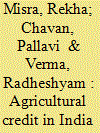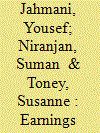|
|
|
Sort Order |
|
|
|
Items / Page
|
|
|
|
|
|
|
| Srl | Item |
| 1 |
ID:
144515


|
|
|
|
|
| Summary/Abstract |
The period of the 2000s witnessed a sharp revival in agricultural credit in India that was largely policy induced. There were emerging shifts in institutional, functional and regional distributions of agricultural credit during the decade. This study attempts to explore the relationship between agricultural credit and agricultural production/productivity. The state-level panel model attempted in this article suggests a positive impact of the intensity of agricultural credit on total factor productivity in agriculture. The impact was relatively stronger with respect to direct agricultural credit. A case study of the (combined) state of Andhra Pradesh also suggests a positive association between agricultural credit and agricultural production. The study lends credence to the policy approach of including agriculture, the largest employer in the Indian economy, as a sector for priority credit in India. It also highlights the point that the sector deserves continued policy support in order to move onto a sustainable and higher growth path.
|
|
|
|
|
|
|
|
|
|
|
|
|
|
|
|
| 2 |
ID:
144516


|
|
|
|
|
| Summary/Abstract |
Using choice experiments, we estimate the willingness to pay for price insurance among cotton and paddy farmers in the Indian state of Gujarat. We also identify the interactions between the demand for price insurance and existing informal and formal risk management mechanisms. Our results indicate that cotton farmers value price insurance more than paddy farmers. Also, most of the existing informal risk management strategies seem to have a positive effect on the demand for price insurance, suggesting potential complementarities. Important policy implications on the design and bundling of innovative financial products follow from our findings.
|
|
|
|
|
|
|
|
|
|
|
|
|
|
|
|
| 3 |
ID:
144518


|
|
|
|
|
| Summary/Abstract |
This article investigates earnings management during the recession and recovery periods (2008 and 2013) for S&P 500 companies. Using the modified Jones model, the results suggest that these companies managed their earnings in both periods, but they managed their earnings much more in the recession period, which may be attributed to the desire to avoid or mitigate the negative consequences of experiencing deep losses. The results also raise questions about the reliability of the companies’ financial statements. The findings of this research are useful to the Securities and Exchange Commission and auditors, and they imply that more careful scrutinisation of companies’ financial statements is needed to better inform investors and creditors relying on these statements.
|
|
|
|
|
|
|
|
|
|
|
|
|
|
|
|
| 4 |
ID:
144517


|
|
|
|
|
| Summary/Abstract |
This article examines the location pattern of unorganised manufacturing enterprises across districts in India. Using a unique data set of 435 districts spread across 25 states, drawn from the Enterprise Survey data of the National Sample Survey (NSS) 1994–95 and 2005–06 ‘thick’ rounds, we find that unorganised manufacturing enterprises are concentrated in a few leading districts, mostly in the metropolitan areas, but their share has declined in the post-reform (post-1991) period, and some new metropolises and suburban districts have emerged as new industrial destinations. The spatial concentration in the distribution of the unorganised manufacturing enterprises across districts has marginally declined—both at the aggregated and disaggregated industry level—in the post-reform period. Our econometric analysis shows that the level of economic development, infrastructure facilities, labour productivity, capital productivity, population size, population density, availability and stock of raw materials, presence and size of organised industries and urbanisation have significant positive effects on the location of unorganised manufacturing enterprises, while economic diversity has a strong negative impact. The specificity of our study is that we use district-level data, which allows us to provide a relatively comprehensive view of the location pattern of unorganised manufacturing enterprises in India.
|
|
|
|
|
|
|
|
|
|
|
|
|
|
|
|
| 5 |
ID:
144519


|
|
|
|
|
| Summary/Abstract |
This article attempts to determine the method of volatility estimation that prices the CNX Nifty Index options closest to the theoretical price as computed by the Black–Scholes (1973) model. Volatility has been estimated using simple variance, implied volatility, volatility index and the asymmetrical exponential generalised auto-regressive conditional heteroskedasticity (EGARCH) (1,1) model with generalised error distribution innovations. The trend in mispricing has been studied using error estimates and non-parametric tests. Our findings indicate significant mispricing in CNX Nifty Index options. The results of our study will have major implications for investors who use options as part of their portfolios and corporates who use them for risk hedging. Our study is important, as there are only a few studies that examine the pricing efficiency of options with a focus on volatility modelling. Also, our study spans a longer time period than the previous studies.
|
|
|
|
|
|
|
|
|
|
|
|
|
|
|
|
|
|
|
|
|